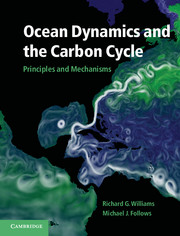Book contents
- Frontmatter
- Contents
- Preface
- Acknowledgements
- Illustration credits
- Part I Introduction
- Part II Fundamentals
- Part III Physical Phenomena and their Biogeochemical Signals
- 7 Seasonality of the upper ocean
- 8 Ocean gyres and intense currents
- 9 Ocean eddies
- 10 Ventilation
- 11 Cycling and transport of nutrients and carbon
- 12 The deep ocean and overturning
- Part IV Synthesis
- Appendix
- Symbols and definitions
- Glossary
- Answers
- References
- Index
- Plate section
11 - Cycling and transport of nutrients and carbon
from Part III - Physical Phenomena and their Biogeochemical Signals
Published online by Cambridge University Press: 05 June 2012
- Frontmatter
- Contents
- Preface
- Acknowledgements
- Illustration credits
- Part I Introduction
- Part II Fundamentals
- Part III Physical Phenomena and their Biogeochemical Signals
- 7 Seasonality of the upper ocean
- 8 Ocean gyres and intense currents
- 9 Ocean eddies
- 10 Ventilation
- 11 Cycling and transport of nutrients and carbon
- 12 The deep ocean and overturning
- Part IV Synthesis
- Appendix
- Symbols and definitions
- Glossary
- Answers
- References
- Index
- Plate section
Summary
Phytoplankton require sunlight and nutrients to grow in the surface ocean. Sustaining phytoplankton growth is difficult in the open ocean because organic particles fall through gravity out of the sunlit, surface ocean into the dark interior, taking essential nutrient elements with them. Without ocean circulation the surface ocean would become a marine desert lacking the nutrients to support photosynthesis. Instead, physical processes continually resupply nutrients to the surface ocean, leading to some interesting consequences: phytoplankton are most abundant at high latitudes and least in the mid latitudes of the open ocean, reflecting the effect of the circulation and mixing of nutrients, rather than the pattern of insolation.
In the dark interior below the sunlit surface layer, inorganic nutrient and carbon distributions are controlled by a combination of physical transport and mixing processes, as well as biologically achieved respiration of organic matter and regeneration of inorganic form, as depicted in Fig. 11.1. Physical transport leads to a layered structure in the inorganic nutrient and carbon distributions over the globe, while respiration increases inorganic concentrations in the waters which have resided at depth for the longest time.
In this chapter, we start in the surface waters and discuss how the growth of phytoplankton is maintained, focussing on the physical transport of nutrients over the North Atlantic. We address the role of boundary currents, physical transfers between the mixed layer and interior, and convection within the surface mixed layer. We discuss how phytoplankton growth is sustained over the mid-latitude subtropical gyres, where windinduced downwelling inhibits the surface supply of nutrients.
- Type
- Chapter
- Information
- Ocean Dynamics and the Carbon CyclePrinciples and Mechanisms, pp. 260 - 289Publisher: Cambridge University PressPrint publication year: 2011



